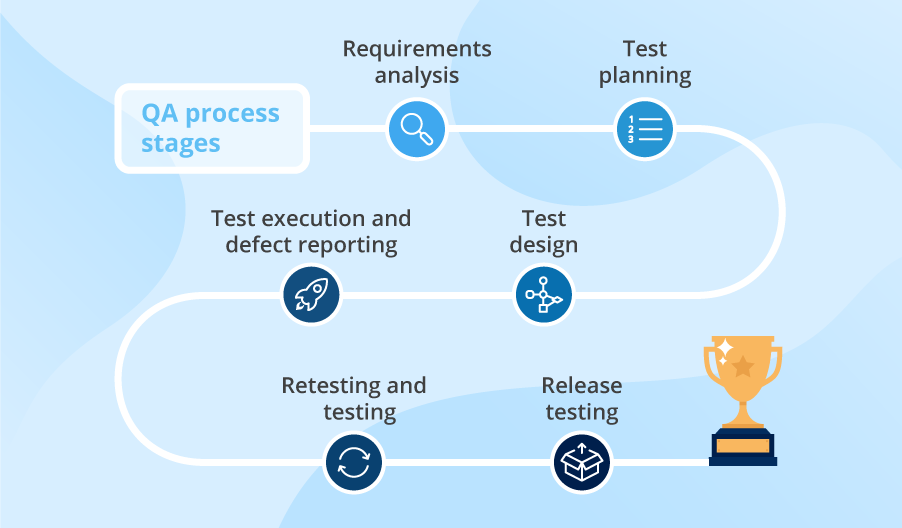
Testing is the process for analyzing the software item to detect the differences between existing and required conditions (defects /bugs /errors) and to evaluate the features of the software item.
Software Testing is a way to ensure that the end product matches the expected standards. The main aim of software testing such as:
Also, the Software Testing provides an impartial and independent view of the software, which helps understand its pros and cons.
Software Testing important
It’s essential to ensure the superior functioning of the software. Various losses can be avoided by testing software before implementing it. Software Testing offers numerous advantages, by making it a crucial step before delivering the final product for the customer.
Advantages of Software Testing
There are five advantages for software testing such as:
These are ten steps software testing process is an experience based on the practical approach for solution to test assignment.
Step 1: Build Phase Testing –
The method chosen to build software from internal design document will determine type and extensiveness of testers needed. As the construction becomes more automated, less testing is going to be required during this phase. Nevertheless, if software is made using waterfall process, it is subject to error and will be verified. Experience has shown that it is significantly cheaper to spot defects during development phase, than through dynamic testing during test execution step.
Step 2: Assess Development Plan and Status –
This initiative may be prerequisite to putting together Verification, Validation, and Testing Plan won’t to evaluate implemented software solution. During this step, testers challenge completeness and correctness for the event plan. Based on extensiveness and completeness of Project Plan testers can estimate quantity of resources they are going to go to test implemented software solution.
Step 3: Develop the Test Plan –
Forming plan for testing will follow an equivalent pattern as any software planning process. The structure for all plans should be an equivalent but content will vary supported degree for the risk testers perceive as related to software being developed.
Step 4: Test Software Requirements
Inaccurate, incomplete and inconsistent requirements cause most software failures. The inability to get requirement right during requirements gathering phase can also increase cost of implementation significantly. Testers, through verification, must determine that requirements are accurate, complete, and they don’t conflict with other.
Step 5: Test Software Changes and Evaluate Test Effectiveness
Within context of performing maintenance after software is implemented, concept is additionally applicable to changes throughout implementation process. Whenever requirements changes, test plan must change and impact for the change on software systems must be tested and evaluate. Testing improvement can best be achieved of evaluating effectiveness for testing at top of every software test assignment. While this assessment is primarily performed by testers, it should involve users of software, developers and quality assurance professionals if function exists within the IT organization.
Step 6: Execute and Record Result
These involves testing for code during dynamic state. The approach, methods, and tools laid out in test plan are going to be wont to validate that executable code actually meets stated software requirements and the structural specifications of design.
Step 7: Acceptance Test
Acceptance testing enables users to gauge applicability or usefulness of software in performing their day-to-day job functions. This tests what user believes software should perform, as against what documented requirements state software should be perform.
Step 8: Report Test Results
Test reporting is continuous process. It may be both oral and written. It’s important that defects and concerns be reported to the appropriate parties as early as possible, so that corrections can be made at the lowest possible cost.
Step 9: The Software Installation
once test team has confirmed that software is prepared for the production use, power to execute that software during production environment should be tested. This tests interface to related software, operating software and operating procedures.
Step 10: Test Software Design
Tests for the both external and internal design primarily through verification techniques. The testers are concerned that planning will achieve objectives of wants, also because design being effective and efficient on designated hardware.
Software Testing plays a crucial role for ensuring that the most competent, effective and majorly bug-free software is delivered to your clients. By ensuring that the team select for Software Testing is using the latest tools, models and methods, they can ensure that good quality software will be delivered to you.
Lorem ipsum viverra feugiat. Pellen tesque libero ut justo, ultrices in ligula. Semper at. Lorem ipsum dolor sit amet elit. Non quae, fugiat nihil ad. Lorem ipsum dolor sit amet. Lorem ipsum init dolor sit, amet elit. Dolor ipsum non velit, culpa! elit ut et.
Lorem ipsum dolor sit amet elit. Velit beatae rem ullam dolore nisi esse quasi, sit amet. Lorem ipsum dolor sit amet elit.